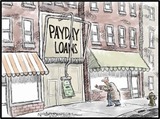
Link to original assignment: https://resourcebank.ca/courseware/lesson/1617/overview
- Subject:
- Financial Literacy
- Material Type:
- Activity/Lab
- Author:
- Cindy Lowe
- Date Added:
- 09/03/2024

Link to original assignment: https://resourcebank.ca/courseware/lesson/1617/overview

ANSWER KEY FOUND HERE FOR QUIZ IN LESSON https://resourcebank.ca/courseware/lesson/1642?__hub_id=37

Forget the stigma and shame. Financial expert Bruce Sellery helps you understand bankruptcy and how to decide whether it's the right decision for your family...

Live and on demand webinars about accounting careers and skills.
Explore online courses, webinars, podcasts and virtual classrooms on a wide range of business and accounting topics. Apply filters to narrow your results by date or topics like leadership, strategy, taxation, finance or sustainability.

Students can explore a (lengthy) article entitled "18 Ways To Make Money Online and Offline in Canada". The article can be shared in groups as there are different sections with different work environments and arrangments. The students can work on two different assignments to explore the vocabulary, short answer, multiple choice and open ended questions to learn more from this article.

Students can explore these two investment game simulations and learn about the purpose of investing, the reasons for diversification of investments and explain the concept of risk tolerance including risk versus reward. Students may also be able to compare the advantages, disadvantages and ethical implications of various types of investments (stocks in this scenario). The STAX game is an interactive game, that allows students to diversify and try to beat the markets over 20 years. The Market Watch game is a simulation that used live prices and trading until the markets close (using fake money). https://www.marketwatch.com/games/fin-lit-sk-2425/portfolio?pub=x05tAm55u24F Password: investnow!

Students can investigate important questions like "Do you talk about money in your home with your family? How about with your friends? Where do you go to learn about money? Why?" with the NGPF presentation. Students will explore the advice from a family member or trusted adult (teacher, principal, etc). using the "Money Interview". Teachers may also use the previous Money Interview Results document and have the students "categorize" the advice (such as savings, investment, credit, career advice, etc). This allows the students to see what other adults have said and learn from the advice of another adult.

The material in this lesson will help students become aware of the warning signs of financial difficulties. When difficulties arise, students should first contact their creditors. Next, efforts should be made to revise spending patterns. In addition, assistance from a Credit Counseling service agencies might be considered. What if these actions do not help?

About this Lesson: In this lesson, students describe the roles of various financial institutions by analyzing bank advertisements. Students will research and then create a media product for a particular financial product or service of their choice. At the end of this lesson, students will use financial terminology fluently to build consumer awareness by investigating products and services offered by financial institutions.Suggested Timing: 2 hours

This workbook will help students understand the various banking fees that can be incurred and aware of the banking options and types of accounts that are suited to individual needs. Students will explore the services offered by banks, trust companies, and credit unions, various fees charged by banking institutions and outline some of the factors to consider when choosing a chequing account.

This collection features resources to support teaching Module 26B: Handling Debt Problems B from the Saskatchewan Financial Literacy curriculum. This activity suggests articles, websites, assignments, and discussion topics to help develop some problem-solving skills in relation to managing debt problems.

Part of micro-economics involves financial decision making at an individual level. Understanding "why" we do what we do, when it comes to decision making, will form an important foundation to making financial decisions. Cognitive Bias is a systematic error in thinking that occurs when people are processing and interpreting information in the world around them and affects the decisions and judgements they make. These two documents allow students and teachers to work through cases and situations where various types of cognitive bias exists and how it may impact decision making.

Meet Mia Saver and Ima Spender are two 23-year-old women who recently graduated from college. For a couple of years after graduation, neither of them saves any money for retirement. Both are focused on establishing their careers and purchasing household items. At age 25, both decide it’s time to start a retirement account. In this activity, we’ll use an online financial calculator to better understand the power of compounding, interest rates and time!

Broke is a documentary about sports stars who went from having millions of dollars to being broke and the mental anguish that comes along with this. The movie explores why this happens, mostly due to how many of the individuals lacked basic financial literacy skills. Students will develop 5 lessons / take-aways that they learned from the movie that the rest of us can learn from? They will discuss the themes and lessons shared regarding making responsible financial decisions, ways to gather information and explore how financial security (or lack of it) can have a major influence on mental health and well-being.

Students will examine current personal money management habits by answering budgeting questions. This activity can help students realize that they are “throwing away” or saving real money based on their choices and actions. You could collect the money that “costs” them and add up the total class amount “spent” on making poor budgeting decisions. Discuss as a class how much has been wasted. Ask the students to reflect on how much money they have left. Did they “spend” all their money or end up with lots of money.

Outcome: FL10.5 Examine the role of personal budgets and their importance for financial planning. Indicator: i. Create and justify a personal budget for a hypothetical scenario that includes income and expenses. Students will read Gabrielle’s story and examine her budget. Use the table or budget sheet to set up and maintain Gabrielle’s budget. Then the students will need to re-do her budget for the next month to make it work that she doesn’t spend more than she earns. There is a final reflection and analysis for the students to learn from this budget activity and how it will help them in the future to budget unanticipated items as well.

This lesson includes full classroom sequence including suggested intro activities, timing, formative and summative activites, and context for teaching. In this lesson, students will identify and review their expenses and income and learn to create a budget. At the end of this lesson, students will: know, understand and/or can distinguish between needs and wants and create a personal budget. According to a FCAC’s 2024 Canadian Financial Wellbeing Survey, 53% of Canadians have household budgets. 62% of respondents say their debt increased by more than $5000 in the past 12 months and only 54% had an emergency fund to cover 3 months of expenses (down from 64% in 2019) 32% of Canadian say they are short on money at the end of the month (vs. 19% in 2019), which means budgeting isn’t going as well as it should be. So, since budgeting seems to aid in your financial health, why don’t most Canadians follow their budget?

Students will work through a budgeting workbook, choosing their expenses and overcoming unexpected items each month. Step 1, the student will use a dice to determine their future job, which will be used throughout the activity. Step 2 guides the students to calculate their take home pay using step by step guide to take off deductions from the paycheck. Step 3 allows the students to make life decisions for how they want to live and determine how much those decisions will costs (tracking the happiness points that go along with each choice). Step 4 is a fun part of the budget where "stuff happens" which impact their monthly finances and happiness points. There is a summary activity to find out if students are able to fund their monthly budget, even with the unexpected. There is a final reflection and analysis for the students to learn from this budget activity. Students will need this workbook, a dice (could be virtual), and a calculator

This collection features resources to support teaching Module 6C: Applying Personal Spending Plans from the Saskatchewan Financial Literacy curriculum. In Round 1, students learn to allocate their "20 bean salary" according to which options they want to spend their beans on. Round 2 forces the students to reduce their salary to 13 beans and make decisions about where they should make their "cuts". Round 3 includes some "life happens" challenges that allow students to make more decisions on where to move the beans in order to deal with the situations. This activity completes with some reflection questions on how this activity relates to budgeting with real income.

This resource provides a listening guide, presentation and student assignment on the topic of "Buy Now, Pay Later", which has become a very popular way to finance everyday purchases. Students are challenged to identify the rise of BNPL programs and how they can "hurt" your credit score and lead to irresponsible borrowing in the future.